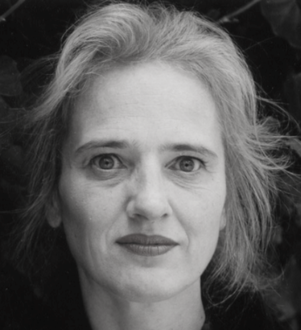Esther Jansma
What it is
1 It is always today, it is always the house which is already old, always the man or woman who looks at the clock, who closes the door and goes off to sleep, to the city, catches the train it is always the same one who stays in the body, regretting the time that is missed as the end softly settles inside snow always drifting over the known wanting to keep it all here, wanting to have by touch the face of the man or woman with its tired eyes – it is this house, the silence here, the white roofs. 2 It is the morning, this window, the hoarfrosted roofs the chimneys like small cold people breathing beneath the drift of grey and white, the mothers and fathers of snow. It is the man who is going off to work. I see that his hands are too small for his bag. I run after him with bread and pills. The streets are like glass, shoppers pass, no-one looks surprised when I fall. The man has long since caught the train. It is the silence of a million flakes, dizzy wind-driven doves, a million times I. It is lying here and spinning with lightness, turning white, thinking of the man on his way. 3 It always happens just like that, it is falling and looking into the light where dust in soft ice-cold dresses tumbles downward and knowing this cold, these particles all mean nothing. But the man on the train is wearing his suit. The train is moving through fields which are white. That is there at least, thinks the woman lying in the street. And she always happens just like that to stand up straight, wipe the snow from her eyes, brush herself down, do the usual, buy a paper. All things fall towards their end, but how can I always know this, at times it slips my mind. |

One theme in the rich oeuvre of poet and novelist Esther Jansma (b. 1958) is how pasts, personal and ancestral, infiltrate the present. This links with her work as Professor of Dendrochronology and Palaeo-Ecology at Utrecht University, where she specialises in the dating of ancient timber and wooden artefacts. Jansma acknowledges Hans Faverey as a poetic influence. However, she brings her own lucidity and sophistication of poetic line to her reflective explorations of time and being, of loss and recovery, which are both philosophically thought through and personally felt. An English-language selection of Jansma’s poems, What It Is (Bloodaxe, Hexham), translated by Francis R. Jones, appeared in 2008.
‘What it is 1, 2 & 3’ are from What It Is, Bloodaxe Books, Northumberland, 2008 http://www.bloodaxebooks.com/ecs/product/what-it-is-880 The original is in Altijd vandaag, De Arbeiderspers, Amsterdam, 2006 |
VERSEVILLE
- Home
- About Us
- Submissions
- Masthead
-
Editions
- Collaborations
- Interviews
-
Prose on Poetry and Poets
-
2010-2013
>
- Sylvia Plath by Dr. Nidhi Mehta >
- Prose Poems of Tagore by Dr. Bina Biswas >
- Kazi Nazrul Islam by Dr. Shamenaz Shaikh >
- Kabir's Poetry by Dr. Anshu Pandey >
- My mind's not right by Dr. Vicky Gilpin >
- On Poetry & Poets by Abhay K.
- Poetry of Kamla Das –A True Voice Of Bourgeoisie Women In India by Dr.Shikha Saxena
- Identity Issues in the Poetry of Nissim Ezekiel by Dr.Arvind Nawale & Prashant Mothe*
- Nissim Ezekiel’s Latter-Day Psalms: His Religious and Philosophical Speculations By Dr. Pallavi Srivastava
- The Moping Owl : the Epitome of Melancholy by Zinia Mitra
- Gary Soto’s Vision of Chicano Experiences: The Elements of San Joaquin and Human Nature by Paula Hayes
- Sri Aurobindo: A Poet By Aju Mukhopadhyay
- Wordsworthian Romanticism in the Poetry of Jayanta Mahapatra: Nature and the Reflective Capabilities of a Poetic Self by Paula Hayes
- Reflective Journey of T.S. Eliot: From Philosophy to Poetry by Syed Ahmad Raza Abidi
- North East Indian Poetry: ‘Peace’ in Violence by Ananya .S. Guha
-
2014-2015
>
- From The Hidden World of Poetry: Unravelling Celtic mythology in Contemporary Irish Poetry Adam Wyeth
- Alchemy’s Drama: Conflict, Resolution and Poiesis in the Poetic Work of Art by Michelle Bitting
- Amir Khushrau: The Musical Soul of India by Dr. Shamenaz
- PUT YOUR HANDS ON ME: POETRY'S EROTIC ART by Elena Karina Byrne
- Celtic and Urban Landscapes in Irish Poetry by Linda Ibbotson
- Trickster at the African Crossroads and the Bridge to the Blues in America by Michelle Bitting
- 2015-2016 >
- 2016-2017 >
- 2017-2018 >
-
2010-2013
>
- Print Editions
Archives |
The Magazine |
|




